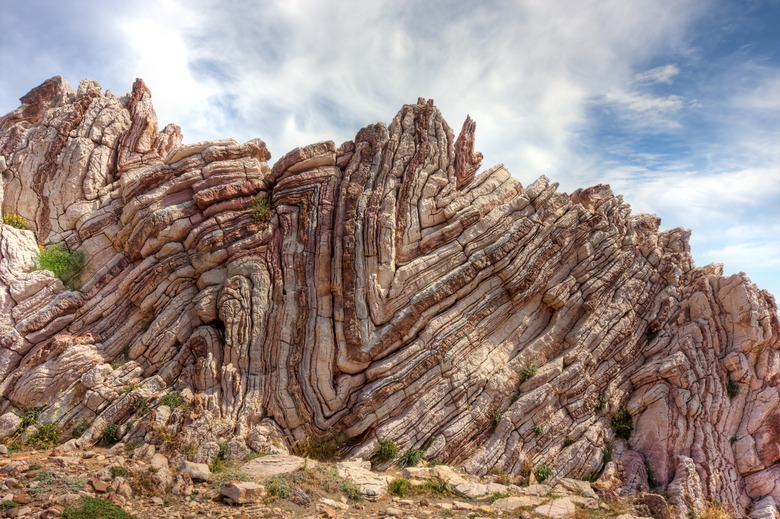What Is Deformation In Earth Science?
What is the definition of deformation in earth science? In general, deformation refers to changes in the shape or position of rocks. Deformation of rocks occurs as a result of stress, which is a force that acts on rocks. There are several terms associated with deformation that help describe the type of force, the stages of deformation and the resulting shapes and position of rocks affected by deformation. The process of deformation takes place over thousands of years, but you can observe the landforms and geological features created by this process across the surface of the planet today.
Types of Stress
Types of Stress
Stress is a force like pressure, and there are three different types of stress in the field of geology: tensional, compressional and shear. Regardless of the type of stress, the force results in strain. When rocks are strained, they change in size or shape, or they move or shift. Strain cannot happen without some kind of stress.
Tensional stress is also called extensional stress, and this force stretches or lengthens rocks. Compressional stress is a force that squeezes a rock, shortening it. Shear stress results in slippage, or parallel movement in opposite directions.
Stress can be measured in units of force, and when the amount of stress applied to a rock is greater than the strength of the rock, deformation happens. Flowing, folding, fracturing and faulting are the results of rock deformation.
Stages of Deformation
Stages of Deformation
Rocks are hard, solid masses of minerals that have been fused together. Although they can appear to be unbreakable, all rocks eventually deform, resulting in smaller fragments that break down even further over time.
The rate of rock deformation depends on a number of factors, but all deformation goes through three successive stages. The three stages of deformation are elastic, ductile and fracture.
In the first stage, elastic deformation, the strain is reversible and the rock will return to its original size and shape once the stress disappears. The strain becomes irreversible in the second stage, ductile deformation, and the rock bends. In the final stage, fracture deformation, the rock breaks.
Factors that affect how rocks respond to stress include temperature, confining pressure, rock composition, strain rate and time. The presence of water also affects how rocks behave when stress is applied. Patterns of deformation correspond to these numerous factors that affect rock strength; for example, igneous rocks tend to be more brittle than sedimentary and metamorphic rocks, which usually exhibit ductile deformation.
Results in Structures
Results in Structures
Ductile deformation in large masses of rocks results in folds, which can be thought of as bends in rocks. Folds result in a variety of shapes and landforms, including monoclines, anticlines and synclines. The differences in these types of folds relate to whether layers are bent upward, downward or horizontally. Domes and basins are also formed as a result of ductile deformation; basins are like bowls, and domes are like upside-down bowls.
Joints and faults are the results of fracture deformation. Joints are fractures in rocks with no slippage, and faults are fractures where there has been movement or slippage.
Although joints are fractures that are not offset, these cracks do provide an entry point for water, which can lead to the formation of veins of minerals like quartz or calcite. Physical weathering can occur as a result of the freezing and thawing of water in joints, and chemical weathering may also break down rocks with joints.
There are several types of faults, which are joints in rocks where there is slippage. Types of faults include dip-slip faults, strike-slip faults and oblique-slip faults. These types of faults relate to the direction of movement along the fracture in the rock.
Cite This Article
MLA
Sloane, Christina. "What Is Deformation In Earth Science?" sciencing.com, https://www.sciencing.com/deformation-earth-science-21924/. 20 October 2021.
APA
Sloane, Christina. (2021, October 20). What Is Deformation In Earth Science?. sciencing.com. Retrieved from https://www.sciencing.com/deformation-earth-science-21924/
Chicago
Sloane, Christina. What Is Deformation In Earth Science? last modified August 30, 2022. https://www.sciencing.com/deformation-earth-science-21924/
